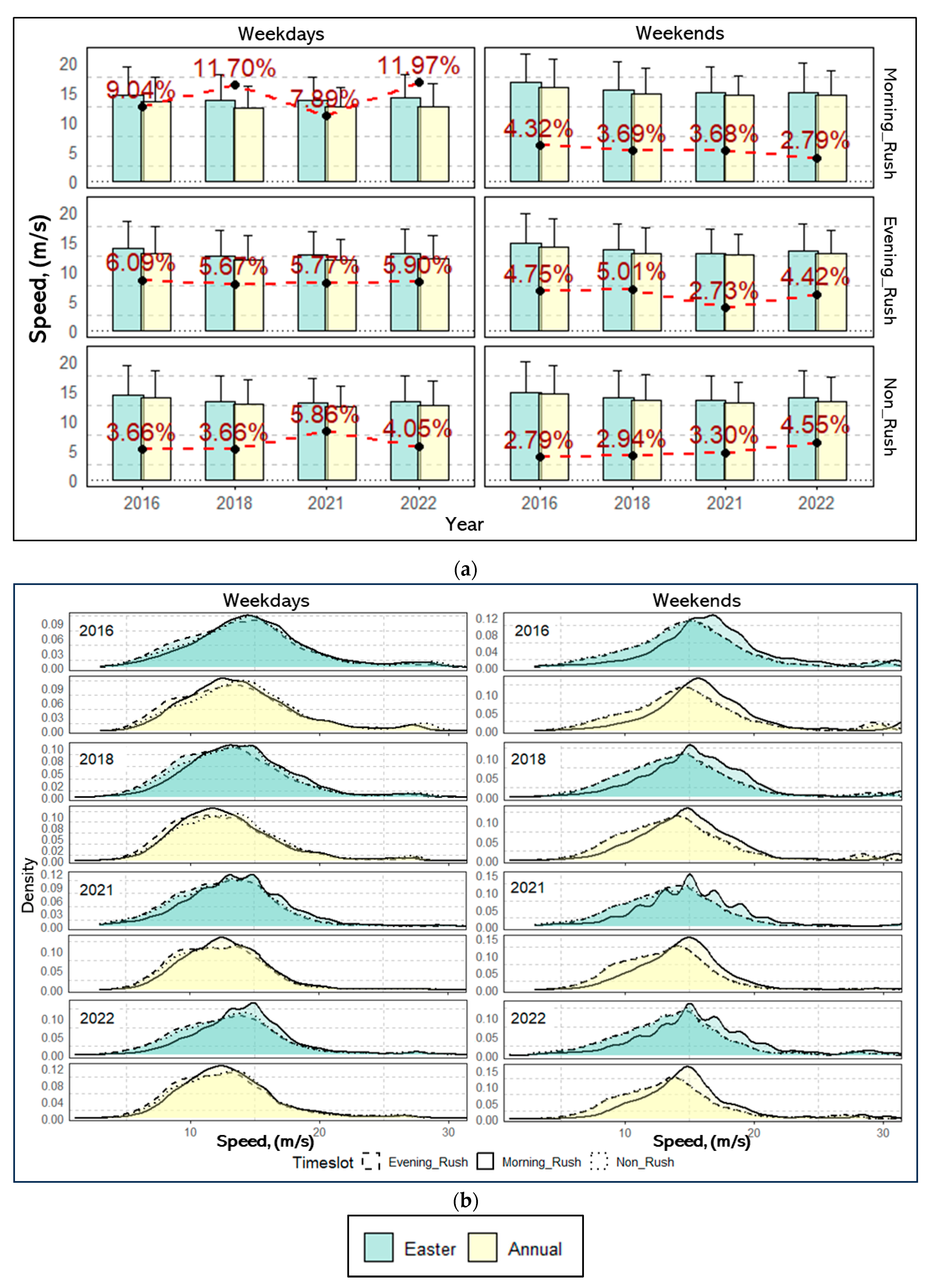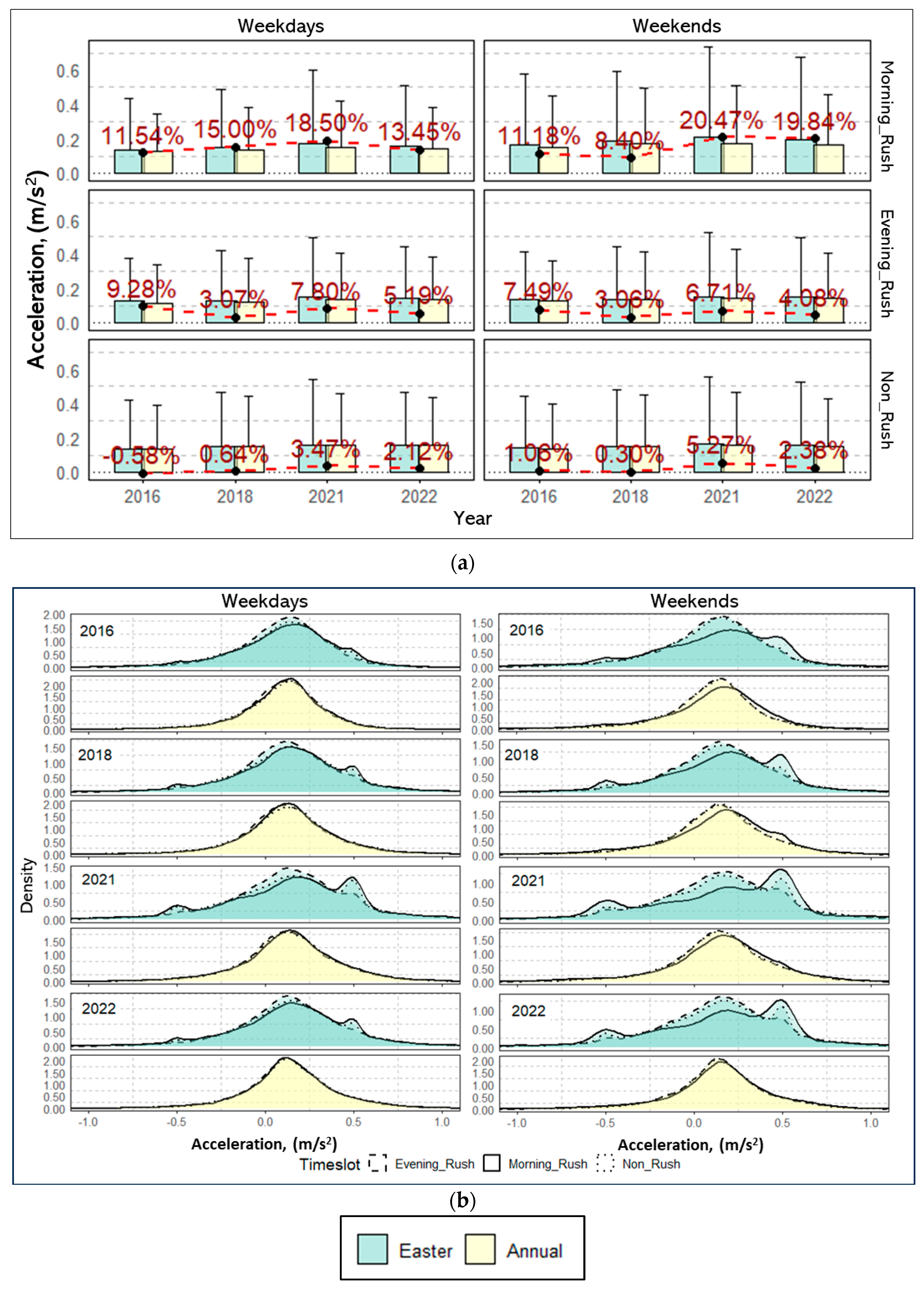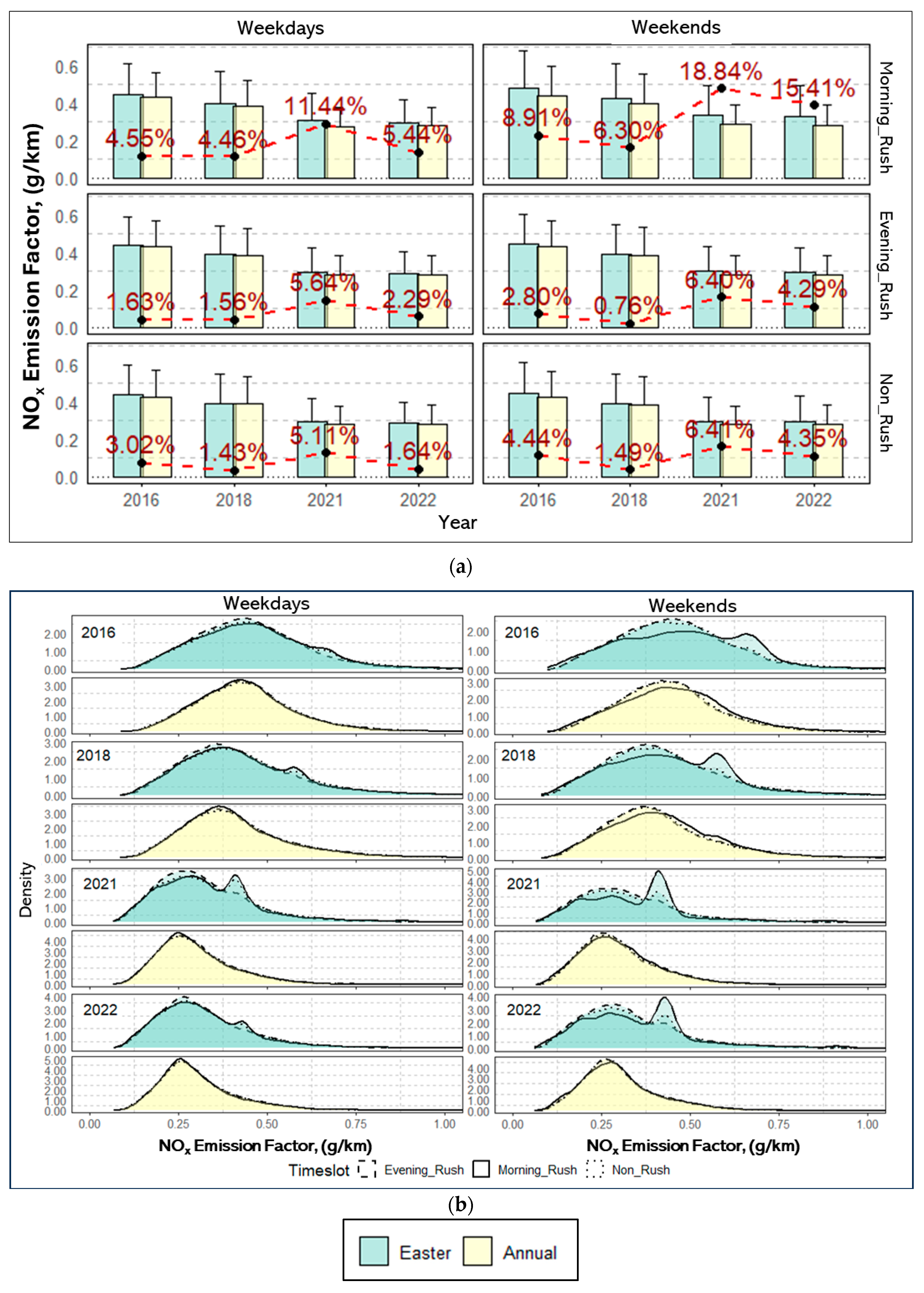Assessing the Impact of Calendar Events upon Urban Vehicle Behaviour and Emissions Using Telematics Data
Abstract
:Highlights
- During Easter holidays, vehicles exhibited more dynamic driving patterns compared to the average annual periods, with increases in speed (~4%), acceleration (3–4%), and vehicle-specific power (7–9%). The more active driving behaviour resulted in higher emissions per vehicle, with CO2 and NO2 emission factors increasing by 3–8% and 4–10%, respectively.
- The effect of Easter holidays on overall CO2 and NO2 emissions in 2022 was not uniform across time and location. By integrating road occupancy data, this study revealed contrasting outcomes: major roads experienced substantial decreases in emissions (15–25%) during weekday peak hours, while urban roads saw slight increases during weekend rush periods. This variability highlights the complex interplay between holiday traffic flow patterns and emission levels across different road types and times.
- This study calls into question the assumption that a reduction in traffic automatically results in lower emissions per vehicle. This is evidenced by the observation that individual vehicle emission factors are higher during less congested holiday periods.
- The substantial decline in overall emissions during Easter, despite an increase in per-vehicle emissions, highlights the pivotal role of traffic volume in urban air quality management. This finding suggests that strategies focusing on reducing the number of vehicles on the road, such as promoting public transportation or encouraging remote work during peak periods, may prove more effective in lowering total emissions than solely targeting individual vehicle efficiency in urban environments.
Abstract
1. Introduction
2. Materials and Methods
2.1. Telematics Data
2.2. Geospatial and Temporal Mapping of Urban Mobility (GSTMUM)
2.3. Spatial and Temporal Scope of This Study


2.4. Fleet Composition and Traffic Data
2.5. The Method to Evaluate the Effect of Calendar Events
3. Results and Discussions
3.1. Travel Characteristics
3.1.1. Vehicle (Traffic Flow) Speed
3.1.2. Vehicle Acceleration
3.1.3. Vehicle-Specific Power (VSP)
3.2. Transport Environment Characteristics, Vehicle Emission Factors
3.2.1. CO2 Emission Factor
3.2.2. NOx Emission Factor
3.3. Easter’s Impact on Travel Characteristics and Road Emissions
4. Conclusions
Supplementary Materials
Author Contributions
Funding
Data Availability Statement
Conflicts of Interest
References
- Pradhan, R.P. Investigating the causal relationship between transportation infrastructure, financial penetration and economic growth in G-20 countries. Res. Transp. Econ. 2019, 78, 100766. [Google Scholar] [CrossRef]
- Department for Transport; Driver and Vehicle Licensing Agency. Vehicle Licensing Statistics: Annual 2020. 2021. Available online: https://www.gov.uk/government/statistics/vehicle-licensing-statistics-2020 (accessed on 20 October 2024).
- BTS. Transportation Economic Trends; Contribution of Transportation to the Economy: Final Demand Attributed to Transportation; Bureau of Transportation Statics: Washington, DC, USA, 2022.
- European Comission. EU Transport in Figures; European Comission: Brussels, Belgium, 2022.
- EEA. Sources and Emissions of Air Pollutants in Europe; European Environmental Agency: Copenhagen, Denmark, 2022.
- Thana Singam, V.; Mohd Zahari, H.; Mohamad Rafiuddin, N. A systematic review on carbon emission of light duty vehicles in urban environment. Soc. Sci. Humanit. Open 2024, 10, 100924. [Google Scholar] [CrossRef]
- Zhang, Y.; Yang, X.; Wang, Y.; Yang, Z.; Zhao, H.; Ding, Y. Light-duty vehicle organic gas emissions from tailpipe and evaporation: A review of influencing factors. Sci. Total Environ. 2024, 947, 174523. [Google Scholar] [CrossRef]
- Harrison, R.M.; Allan, J.; Carruthers, D.; Heal, M.R.; Lewis, A.C.; Marner, B.; Murrells, T.; Williams, A. Non-exhaust vehicle emissions of particulate matter and VOC from road traffic: A review. Atmos. Environ. 2021, 262, 118592. [Google Scholar] [CrossRef]
- Brusselaers, N.; Macharis, C.; Mommens, K. The health impact of freight transport-related air pollution on vulnerable population groups. Environ. Pollut. 2023, 329, 121555. [Google Scholar] [CrossRef] [PubMed]
- Luo, Z.; Wang, Y.; Lv, Z.; He, T.; Zhao, J.; Wang, Y.; Gao, F.; Zhang, Z.; Liu, H. Impacts of vehicle emission on air quality and human health in China. Sci. Total Environ. 2022, 813, 152655. [Google Scholar] [CrossRef]
- Ritchie, H. Cars, Planes, Trains: Where Do CO2 Emissions from Transport Come from? 2020. Available online: https://ourworldindata.org/ (accessed on 20 October 2024).
- Wang, X.-C.; Klemeš, J.J.; Dong, X.; Fan, W.; Xu, Z.; Wang, Y.; Varbanov, P.S. Air pollution terrain nexus: A review considering energy generation and consumption. Renew. Sustain. Energy Rev. 2019, 105, 71–85. [Google Scholar] [CrossRef]
- Ghaffarpasand, O.; Talaie, M.R.; Ahmadikia, H.; TalaieKhozani, A.; Shalamzari, M.D.; Majidi, S. How does unsustainable urbanization affect driving behavior and vehicular emissions? Evidence from Iran. Sustain. Cities Soc. 2021, 72, 103065. [Google Scholar] [CrossRef]
- Yassine, C.; Sebos, I. Quantifying COVID-19’s impact on GHG emission reduction in Oman’s transportation sector: A bottom-up analysis of pre-pandemic years (2015–2019) and the pandemic year (2020). Case Stud. Transp. Policy 2024, 16, 101204. [Google Scholar] [CrossRef]
- Ghaffarpasand, O.; Blake, R.; Shalamzari, Z.D. How international conflicts and global crises can intertwine and affect the sources and levels of air pollution in urban areas. Environ. Sci. Pollut. Res. 2024, 31, 51619–51632. [Google Scholar] [CrossRef]
- Hua, J.; Zhang, Y.; de Foy, B.; Mei, X.; Shang, J.; Feng, C. Competing PM2.5 and NO2 holiday effects in the Beijing area vary locally due to differences in residential coal burning and traffic patterns. Sci. Total Environ. 2021, 750, 141575. [Google Scholar] [CrossRef] [PubMed]
- Yousefian, F.; Faridi, S.; Azimi, F.; Aghaei, M.; Shamsipour, M.; Yaghmaeian, K.; Hassanvand, M.S. Temporal variations of ambient air pollutants and meteorological influences on their concentrations in Tehran during 2012–2017. Sci. Rep. 2020, 10, 292. [Google Scholar] [CrossRef] [PubMed]
- Chen, P.-Y.; Tan, P.-H.; Chou, C.C.-K.; Lin, Y.-S.; Chen, W.-N.; Shiu, C.-J. Impacts of holiday characteristics and number of vacation days on “holiday effect” in Taipei: Implications on ozone control strategies. Atmos. Environ. 2019, 202, 357–369. [Google Scholar] [CrossRef]
- Basagaña, X.; Triguero-Mas, M.; Agis, D.; Pérez, N.; Reche, C.; Alastuey, A.; Querol, X. Effect of public transport strikes on air pollution levels in Barcelona (Spain). Sci. Total Environ. 2018, 610, 1076–1082. [Google Scholar] [CrossRef]
- Ghaffarpasand, O.; Okure, D.; Green, P.; Sayyahi, S.; Adong, P.; Sserunjogi, R.; Bainomugisha, E.; Pope, F.D. The impact of urban mobility on air pollution in Kampala, an exemplar sub-Saharan African city. Atmos. Pollut. Res. 2024, 15, 102057. [Google Scholar] [CrossRef]
- Ghaffarpasand, O.; Burke, M.; Osei, L.K.; Ursell, H.; Chapman, S.; Pope, F.D. Vehicle Telematics for Safer, Cleaner and More Sustainable Urban Transport: A Review. Sustainability 2022, 14, 16386. [Google Scholar] [CrossRef]
- Xiang, J.; Ghaffarpasand, O.; Pope, F.D. Mapping urban mobility using vehicle telematics to understand driving behaviour. Sci. Rep. 2024, 14, 3271. [Google Scholar] [CrossRef] [PubMed]
- Ghaffarpasand, O.; Pope, F.D. Telematics data for geospatial and temporal mapping of urban mobility: New insights into travel characteristics and vehicle specific power. J. Transp. Geogr. 2024, 115, 103815. [Google Scholar] [CrossRef]
- Ghaffarpasand, O.; Pope, F.D. Telematics data for geospatial and temporal mapping of urban mobility: Fuel consumption, and air pollutant and climate-forcing emissions of passenger cars. Sci. Total Environ. 2023, 894, 164940. [Google Scholar] [CrossRef]
- Huertas, J.I.; Giraldo, M.; Quirama, L.F.; Díaz, J. Driving Cycles Based on Fuel Consumption. Energies 2018, 11, 3064. [Google Scholar] [CrossRef]
- Yuhui, P.; Yuan, Z.; Huibao, Y. Development of a representative driving cycle for urban buses based on the K-means cluster method. Clust. Comput. 2019, 22, 6871–6880. [Google Scholar] [CrossRef]
- Jimenez-Palacios, J.L. Understanding and Quantifying Motor Vehicle Emissions with Vehicle Specific Power and TILDAS Remote Sensing; Massachusetts Institute of Technology: Cambridge, MA, USA, 1998. [Google Scholar]
- Davison, J.; Bernard, Y.; Borken-Kleefeld, J.; Farren, N.J.; Hausberger, S.; Sjödin, Å.; Tate, J.E.; Vaughan, A.R.; Carslaw, D.C. Distance-based emission factors from vehicle emission remote sensing measurements. Sci. Total Environ. 2020, 739, 139688. [Google Scholar] [CrossRef] [PubMed]
- Ghaffarpasand, O.; Talaie, M.R.; Ahmadikia, H.; Khozani, A.T.; Shalamzari, M.D. A high-resolution spatial and temporal on-road vehicle emission inventory in an Iranian metropolitan area, Isfahan, based on detailed hourly traffic data. Atmos. Pollut. Res. 2020, 11, 1598–1609. [Google Scholar] [CrossRef]









| Year | Start and End Dates |
|---|---|
| 2016 | 21st March–10th April |
| 2018 | 27th March–15th April |
| 2021 | 1st April–19th April |
| 2022 | 11th April–22nd April |
Disclaimer/Publisher’s Note: The statements, opinions and data contained in all publications are solely those of the individual author(s) and contributor(s) and not of MDPI and/or the editor(s). MDPI and/or the editor(s) disclaim responsibility for any injury to people or property resulting from any ideas, methods, instructions or products referred to in the content. |
© 2024 by the authors. Licensee MDPI, Basel, Switzerland. This article is an open access article distributed under the terms and conditions of the Creative Commons Attribution (CC BY) license (https://creativecommons.org/licenses/by/4.0/).
Share and Cite
Xiang, J.; Ghaffarpasand, O.; Pope, F.D. Assessing the Impact of Calendar Events upon Urban Vehicle Behaviour and Emissions Using Telematics Data. Smart Cities 2024, 7, 3071-3094. https://doi.org/10.3390/smartcities7060120
Xiang J, Ghaffarpasand O, Pope FD. Assessing the Impact of Calendar Events upon Urban Vehicle Behaviour and Emissions Using Telematics Data. Smart Cities. 2024; 7(6):3071-3094. https://doi.org/10.3390/smartcities7060120
Chicago/Turabian StyleXiang, Junjun, Omid Ghaffarpasand, and Francis D. Pope. 2024. "Assessing the Impact of Calendar Events upon Urban Vehicle Behaviour and Emissions Using Telematics Data" Smart Cities 7, no. 6: 3071-3094. https://doi.org/10.3390/smartcities7060120
APA StyleXiang, J., Ghaffarpasand, O., & Pope, F. D. (2024). Assessing the Impact of Calendar Events upon Urban Vehicle Behaviour and Emissions Using Telematics Data. Smart Cities, 7(6), 3071-3094. https://doi.org/10.3390/smartcities7060120







